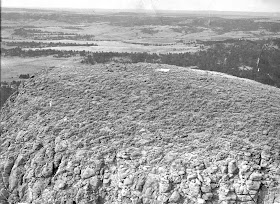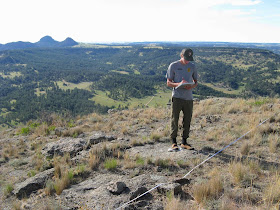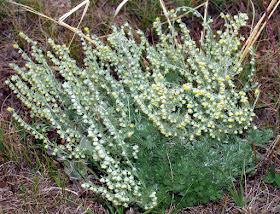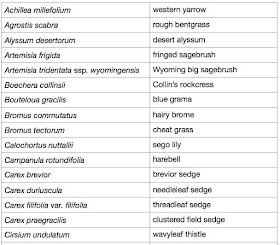 |
|
Devils Tower is so striking that Henry Newton and William P. Jenney featured it as the frontispiece in their 1880 Report on the Geology and Resources of the Black Hills of Dakota.
|
 |
|
“You want to know what’s on top? Let’s go find out!”
|
So I guess I shouldn’t be surprised that my most popular blog post ever is Devils Tower—What’s on Top?, but I am. It’s not about rock climbing or spaceships, but rather plants and vegetation. How many readers really want to know that sagebrush, grass and wildflowers grow on the summit? I think folks land there by accident. In any case, it’s time for an update.
 |
|
In 1941, George Hopkins parachuted onto the summit, where he hung out for six days in grass, sagebrush and rocks before being rescued. NPS archives.
|
This year, the National Park Service contracted with us to inventory plants and assess summit vegetation. In a sense the project is “almost” done. However, I have to finish the report and I hate writing reports. I’d much rather be blogging. A few days ago, I had a brilliant idea—do both at the same time.
This week I'm compiling information about summit plants that would be of interest to visitors. The Park Service will use it in interpretive materials available at the Monument and online, and may add it to employee training. So I’m wondering:
What would you want to know about what’s on top? What would you find interesting and memorable about plants on the summit? (please add Comments below)
 |
|
Andrew and Cheryl commune with plants on top of Devils Tower.
|
This is what I’ve come up with so far (photos are for this blog post only, and not all are from the summit):
The top of Devils Tower is a rounded rocky hilltop. From the high point you wouldn’t know there were precipitous walls below if you hadn’t just struggled up one. Plants are common among the rocks—in fact plant cover roughly equals that of bare rock. Skunkbush sumac bushes and clumps of bluebunch wheatgrass grow scattered across much of the summit. In the northeast part, where the soil is deeper, there’s a small but vigorous stand of sagebrush and grass.
 |
| Andrew admires skunkbush and bluebunch wheatgrass among the rocks. |
How do plants get up there? Wind is the most likely means of seed transport. But small mammals climb Devils Tower too—chipmunks, packrats, and deermice have been seen on the sides and summit. Maybe they haul a few seeds up there on occasion.
How can plants grow in rock? Over the long term, rocks are not as permanent as they look. They fracture, weather, and turn to dust. Dirt and debris slowly accumulate in small pockets, where seeds sometimes land. A few germinate; a few of these grow into plants. Their roots help break up the rock, one tiny bit at a time.
It may seem unlikely that seeds will land in just the right place and survive, but obviously they have. The top of Devils Tower is botanically diverse, with 53 species—impressive considering it’s only the size of a football field and really rocky.
At first glance, the summit looks dry and harsh—hospitable only to hardy drought-tolerant grasses and shrubs. But there are lots of favorable microsites. Thirteen plant species on the summit grow only in the shade of rocks and shrubs. Ferns grow in crevices with shade and soil … and a bit of flowing water when it rains.
In late spring, the summit turns green with grasses and wildflowers. Some of the showier species are sego lily, prickly pear cactus, harebell, western yarrow and wild onion. Common grasses include bluebunch wheatgrass, needle-and-thread, and blue grama. Shrubs are common too, especially skunkbush sumac and Wyoming big sagebrush.
 |
| Rocky Mountain cliff fern (Woodsia scopulorum). ©Adolf Ceska, used with permission. |
Are any plants unique to the summit? No—all grow in the surrounding area too. However, Wyoming big sagebrush is much more common on the top of Devils Tower than anywhere else in the Monument (it’s extremely common further west in the basins of Wyoming).
 |
| Sagebrush grassland on top of Devils Tower; skunkbush sumac lower left. |
Here are a few of the plants that greet rock climbers when they reach the top:
 |
|
Plains prickly pear (Opuntia polyacantha) by Sally and Andy Wasowski.
|
When the large waxy yellow flowers of prickly pear cactus bloom, everyone notices. Otherwise it’s drab and easily overlooked, and painful when accidentally bumped!
Two different kinds of sagebrush grow on the summit: Wyoming big sagebrush and fringed sage. Sagebrush is not related to the sage we use in cooking, but was named for the sage-like fragrance of the leaves.
 |
|
Wyoming big sagebrush (Artemisia tridentata ssp. wyomingensis) by Stan Shebs. Its leaves are 3-toothed at the tip, as the scientific name points out (“tridentata").
|
 |
|
Fringed sage (Artemisia frigida) also lives up to its name. The leaves look “fringed” because they’re divided into fine segments (NPS).
|
The 3-parted leaves of skunkbush sumac suggest poison ivy, and indeed, the two are close relatives. But this sumac is not at all poisonous. In fact, its twigs have long been used to make a citrus-flavored tea. The appealing fragrance explains the scientific name—Rhus aromatica.
 |
|
Skunkbush sumac (Rhus aromatica) by Joseph A. Marcus.
|
Harebells look delicate, but they’re actually quite tough, surviving even where there’s very little soil. They grow in cracks on the sides of the Tower, and among rocks on top.
 |
|
Harebells (Campanula rotundifolia). The scientific name refers to bell-shaped flowers and small round leaves.
|
One of the more common plants on the summit is rock spikemoss, but it’s rarely noticed. It’s a close relative of the resurrection plant, and behaves in a similar fashion. Rock spikemoss grows and produces spores during favorable conditions in late spring and summer. Then it lies dry and dormant, looking quite dead, as it awaits “resurrection” with next year’s spring moisture.
 |
|
Rock spikemoss (Selaginella densa) is not a true moss but rather a relative of ferns.
|
No one expects to find trees on top, but there is one. A ponderosa pine has managed to survive on minimal soil and water in a crack. Never underestimate a plant!
• • •
One more question—what do you think about including scientific names? Botanists like them, as they’re information-rich. But others find them off-putting.
Here’s the current list of summit plants. About thirty were known prior to this project. After systematic careful searching—three visits scattered through the growing season, 20 person hours in all— the known vascular plant flora now stands at 53 species.




Have you had a chance to do the same survey on top of the Missouri Buttes about 4 mi away from devils tower about as high but not quite as steep (and about the same total elevation)? Should be about the same but could be an interesting comparison
ReplyDeleteLyle--that's a neat idea. I was on the highest one about 35 years ago but wasn't looking at plants. I remember we could see a bit of the summit of Devils Tower--the high point of the butte is about 200 feet higher I think. Anyway, from what I remember, the "summit" is more limited--not as big an area before it starts to drop off. Do you know? Would be interesting to check it out. I believe it's on private land; we crossed a ranch to get there.
DeleteThanks for sharing this, very interesting. I think it would nice to know how many native versus non-native species there are. Including scientific names is always a good idea. Even though some people don't use them they can easily ignore them. You kind of suggest that even on the small area that makes up the summit that perhaps there are more than one plant community type up there. If so, you could talk about that and group the plants that belong to those separately and talk about why that is . Perhaps an illustration (top down view) of the summit with the plant communities drawn out. Maybe it would be cool to take up a Trimble and map out the different areas. Just throwing out whatever comes into my head. Again, great job and I look forward to reading more about it.
ReplyDeleteGreat ideas, Anonymous ... you sound like an insider! ;-) Most are in the project report. I'll see what I can pull out and make more easily digested.
DeleteAre there any measures that need to be taken to prevent climbers from transporting noxious weeds or other seed to the top? Any need to treat noxious species up top? Looked like mullein and creeping jenny might be most aggressive. Such a cool blog! Looking forward to continued updates :)
ReplyDeleteAnonymous #2--thanks for visiting! I think climbers are rarely a source of seeds as they don't climb in the shoes they walk in. They carry them up to where the technical climbing starts. I would choose birds and especially wind as the most important vectors. I'm recommending that the Park Service investigate the spots where bindweed and Canada thistle were found (one very small population each). They should dig around a bit to see if roots or rhizomes are still present, and if so, get rid of them while it's possible. In my experience, mullein is easier to deal with, being a biennial. And it's not considered "aggressively invasive" like bindweed and Canada thistle.
DeleteBromus tectorum or Cheatgrass is a non-native. Kinda surprising that it is there.
ReplyDeleteAnonymous #3--I suspect cheatgrass has been on the Tower for a long time. I found it there in 1982, and it was common then. It's been a pest in the western US at least since the 1930s, probably longer. It's tough--probably impossible--to eradicate in situations like the Tower summit, where the vegetation is naturally somewhat sparse.
DeleteFun post, Hollis. Do you think it's changed much since Don Roth and I did our surveys in the 90s? There was cheatgrass then, and lots of scary chipmunks.
ReplyDeleteThanks, Ken. There's no indication it has changed much, including disturbance. I'll send you an email message about it soon. Did you have chipmunk nightmares up there?
DeleteWhat a fun project! Oh, I would definitely include the Latin names--for many reasons, but mostly because international visitors would have a better idea of what plants are present. One tree, huh? I'm surprised that there would be one tree and not more. Interesting.
ReplyDeleteGood point, Beth, about foreign visitors. Thinking about it ... there could well be more pines--seedlings and small saplings not yet visible to botanists. Thanks for the Comment.
DeleteOooh, a mini tepui. No mini brontosauri?
ReplyDeleteI can see some that are obviously going to be distributed by wind (Artemisia, dandelion, horseweed, salsify, ferns and Selaginella) or in faeces (Rhus, "lilies", Ribes, Opuntia) and others are burrs that could be carried by animals (stickseed, grasses such as Hesperostipa). It would be interesting to see how these categories are represented as proportions in the flora at the base and those that got to the top.
Do pine seeds get carried deliberately to store them or are they sticky with pitch?
Always offer the botanical names, people can ignore them if they want. What you call horseweed we call fleabane in the UK.
Great timing Pat the Plant--right now I'm writing educational literature section of final report, and had just recommended including scientific names when your comment popped up as an email message. So I added US horseweed vs. UK fleabane as an example, thanks!
DeleteI had to google tepui ... kinda looks that way doesn't it, but not so interesting. Based on veg, summit seems hardly isolated from its surroundings.
Ponderosa pine seeds are not sticky and they are stashed by jays ... maybe small mammals too, beyond my expertise.
So glad I finally made it over to this post :) It's a very interesting discussion, but you certainly cover most of the questions that would spring to my mind. I'm glad to see you are recommending in favor of including botanical names. The needs of interested, educated, intelligent visitors should be kept in mind too... ;-)
ReplyDeleteThanks for the feedback, Amy. I really hope they include botanical names. Seems more professional for one thing, and I know there are visitors who are interested. But for some reason I'm not optimistic ... past experience I guess.
DeleteAbout the animals at the top - chipmunks and such - is there a stable, overwintering population or is it more likely to be replenished by climbing animals every year?
ReplyDeleteGreat question, Jason ... meaning I don't know the answer ;-) I asked the Chief of Resource Management at the Monument, as they've done quite a few small mammal projects there. But nothing on overwintering summit mammals. Her reply was the same as mine would be:
Delete"I've seen chipmunks all up and down the Tower, on ledges and broken columns. So, my guess is that they don't stay on the summit all year, and instead come down to the base to weather the winter. They seem to have little trouble making the ascent (or descent), so for them it may be no big deal."
We visited the Tower in September this year. It was a magnificent site. And many beautiful species of plant ife. Has anyone had ever taken an EMF( electo magnetic field) reading there?
ReplyDeleteHello Anon. I have no idea regarding EMF, in fact had to look it up :) Maybe ask the Park Service?
DeleteGreat post, thanks for posting it (all those years ago). Coincidentally I've seen several photos of the tower online recently (without looking for them) and one of them reminded me of a story I heard/read. The story goes that some who were first to the top found evidence that native peoples had gotten there before them EG arrowheads, fire pits. I cannot find anything online about this so perhaps that was just an urban myth. Do you happen to know?
ReplyDeleteThx, Anon, glad you enjoyed it. In the time I lived and worked there, I never heard anything about artifacts of native peoples on the summit. But that was awhile ago. You might check with the Park Service there.
Delete